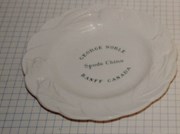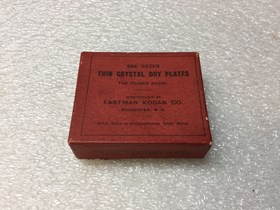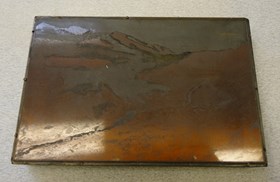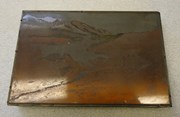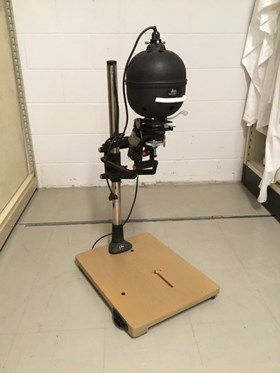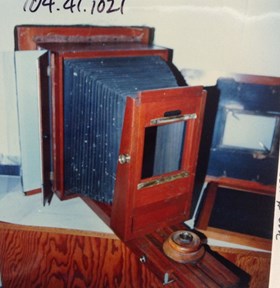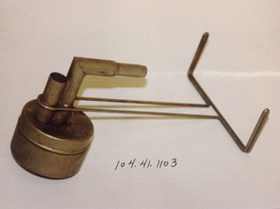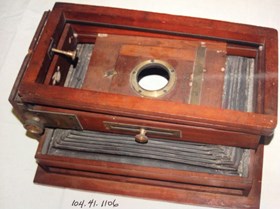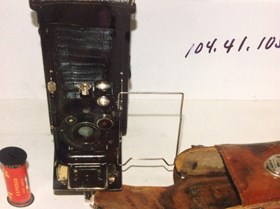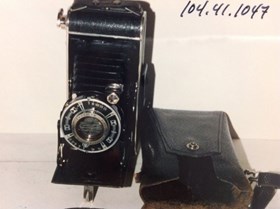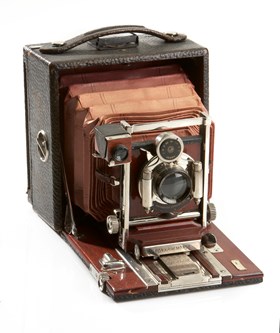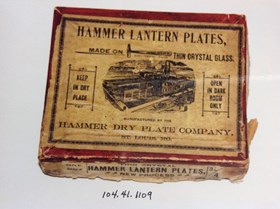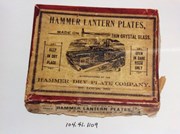Narrow Results By
- Date
- 1920 – 1940
- Material
- ceramic
- Catalogue Number
- 104.20.1104
- Description
- Small white china plate with a scalloped edge and three tulips and leaves in relief on the rim. The plate has green printing on the face: “George Noble Spode China Banff, Canada” and the Copeland Spode trademark on the bottom.
1 image
- Title
- Dish
- Date
- 1920 – 1940
- Material
- ceramic
- Description
- Small white china plate with a scalloped edge and three tulips and leaves in relief on the rim. The plate has green printing on the face: “George Noble Spode China Banff, Canada” and the Copeland Spode trademark on the bottom.
- Credit
- Purchased from Phyllis Cain, Banff, 1988
- Catalogue Number
- 104.20.1104
Images
This material is presented as originally created; it may contain outdated cultural descriptions and
potentially offensive content.
Read more.
- Date
- 1890 – 1910
- Material
- metal
- Catalogue Number
- 110.02.1011
- Description
- Metal tube with lid and paper label reading: “Glaciers. From Will’s office. 2/4. 1909.” Contained 3 drawings on linen (now in Archives Inventory 2014 ).
- Title
- Document Tube
- Date
- 1890 – 1910
- Material
- metal
- Dimensions
- 4.0 x 35.5 cm
- Description
- Metal tube with lid and paper label reading: “Glaciers. From Will’s office. 2/4. 1909.” Contained 3 drawings on linen (now in Archives Inventory 2014 ).
- Credit
- Gift of Molly Vaux, New York, USA, 1999
- Catalogue Number
- 110.02.1011
This material is presented as originally created; it may contain outdated cultural descriptions and
potentially offensive content.
Read more.
- Date
- 1920 – 1940
- Material
- cardboard; paper; glass;
- Catalogue Number
- 104.41.0220
- Description
- Box of one dozen Thin Crystal Dry Plates for a Pocket Kodak camera. The box’s seal has been broken - inside are alternating layers of thin black paper and the glass plates, which are fogged.Dry plate, or the gelatin process, was invented by Dr. Richard L. Maddox in 1871 and replaced the more time-c…
1 image
- Title
- Dry Plates
- Date
- 1920 – 1940
- Material
- cardboard; paper; glass;
- Dimensions
- 1.9 x 6.0 x 5.1 cm
- Description
- Box of one dozen Thin Crystal Dry Plates for a Pocket Kodak camera. The box’s seal has been broken - inside are alternating layers of thin black paper and the glass plates, which are fogged.Dry plate, or the gelatin process, was invented by Dr. Richard L. Maddox in 1871 and replaced the more time-consuming wet plate, or collodion process, which required active wet chemicals to be prepared in mobile dark rooms. The dry plate process underwent several adaptations throughout the 1870s and, in 1879, George Eastman developed a method of applying the emulsion layer to glass in a factory setting, simultaneously creating what came to be known as the Eastman Kodak Co. and bringing down the cost of photography so as to be accessible to the masses.
- Subject
- photography
- photographic equipment
- Credit
- Gift of Catharine Robb Whyte, O. C., Banff, 1979
- Catalogue Number
- 104.41.0220
Images
This material is presented as originally created; it may contain outdated cultural descriptions and
potentially offensive content.
Read more.
Engraving Plate
https://archives.whyte.org/en/permalink/artifact104.43.1011
- Date
- 1890 – 1910
- Material
- wood; metal; paper
- Catalogue Number
- 104.43.1011
- Description
- Two metal engraving plates mounted on wooden blocks. a) has image of mountain scene with glacier. Written on back of block: “Last Cut. 1501. William S. Vaux Jr. 1715 Arch St. Philada.” b) has paper label affixed to back of block: “American [?] Glacier,” handwritten on side of block: “Asulkan Glacie…
1 image
- Title
- Engraving Plate
- Date
- 1890 – 1910
- Material
- wood; metal; paper
- Dimensions
- 2.5 x 12.0 x 18.0 cm
- Description
- Two metal engraving plates mounted on wooden blocks. a) has image of mountain scene with glacier. Written on back of block: “Last Cut. 1501. William S. Vaux Jr. 1715 Arch St. Philada.” b) has paper label affixed to back of block: “American [?] Glacier,” handwritten on side of block: “Asulkan Glacier” and front has image of mountain with glacier and rocks. Stamped on side of block: “Electro Light Engraving Co. New York.”
- Credit
- Gift of Molly Vaux, New York, USA, 1999
- Catalogue Number
- 104.43.1011
Images
This material is presented as originally created; it may contain outdated cultural descriptions and
potentially offensive content.
Read more.
- Date
- 1920 – 1945
- Material
- wood; metal; glass; plastic;
- Catalogue Number
- 104.41.0170
- Description
- Black and silver metal Leitz negative enlarger mounted on a wooden base. The enlarger consists of an almost round light housing with the power cord coming out from the top - immediately below the globe is a series of plates containing the various filters and lenses, as well as the mounting gear tha…
1 image
- Title
- Enlarger
- Date
- 1920 – 1945
- Material
- wood; metal; glass; plastic;
- Dimensions
- 95.8 x 41.7 x 51.9 cm
- Description
- Black and silver metal Leitz negative enlarger mounted on a wooden base. The enlarger consists of an almost round light housing with the power cord coming out from the top - immediately below the globe is a series of plates containing the various filters and lenses, as well as the mounting gear that attaches the enlarger to the silver metal stand. The enlarger is attached to the stand with adjustable arms and a spring that can be released with a small lever so that the device can be moved closer to or further away from the wooden base.
- Credit
- Gift of Nicholas Morant, Banff, 2006
- Catalogue Number
- 104.41.0170
Images
This material is presented as originally created; it may contain outdated cultural descriptions and
potentially offensive content.
Read more.
Enlarging Camera
https://archives.whyte.org/en/permalink/artifact104.41.1021%20a-c
- Date
- 1897 – 1915
- Material
- wood; brass; cloth; glass
- Catalogue Number
- 104.41.1021 a-c
- Description
- Enlarging view camera with two backs; mahogany wood construction; rubberized cloth bellows; some brass fittings;front piece rides on track; brass knob on side moves lens mounting plate; 2 pieces for tracks tightening wood knob; slots for glass plates behind hinged door; one plate clear glass, one p…
1 image
- Title
- Enlarging Camera
- Date
- 1897 – 1915
- Material
- wood; brass; cloth; glass
- Dimensions
- 61.0 x 56.4 x 46.0 cm
- Description
- Enlarging view camera with two backs; mahogany wood construction; rubberized cloth bellows; some brass fittings;front piece rides on track; brass knob on side moves lens mounting plate; 2 pieces for tracks tightening wood knob; slots for glass plates behind hinged door; one plate clear glass, one plate frosted glass; large slot for backs to slide in; two backs: one 42.3 x 33.1; other 59.9 x 41.9; the smaller back has two black slides, sheet frosted glass, cardboard divider; larger back has an area in centre with piece of glass with clips; carpet nailed around edges of slot and also perimeter of back piece; manufacturer's name plate loose.
- Subject
- photography
- Byron Harmon
- Credit
- Gift of Don Harmon, Banff, 1966
- Catalogue Number
- 104.41.1021 a-c
Images
This material is presented as originally created; it may contain outdated cultural descriptions and
potentially offensive content.
Read more.
- Date
- 1890 – 1900
- Material
- cardboard;
- Catalogue Number
- 110.01.0293 a-c
- Description
- Three empty boxes for one Transparent Film Cartridge meant to be used in the Kodak No. 2 Bullet Camera - each cartridge could take twelve 3 1/2 inch exposures. Each box has a black and white paper label adhered across the top of the lid with the product and manufacturer details printed throughout -…
1 image
- Title
- Film Box
- Date
- 1890 – 1900
- Material
- cardboard;
- Dimensions
- 3.8 x 4.0 x 10.3 cm
- Description
- Three empty boxes for one Transparent Film Cartridge meant to be used in the Kodak No. 2 Bullet Camera - each cartridge could take twelve 3 1/2 inch exposures. Each box has a black and white paper label adhered across the top of the lid with the product and manufacturer details printed throughout - on the bottom is a white and red paper label with a warning to develop the film before May 1st, 1900. All three boxes have various kinds of writing throughout the exteriors - two have notes written on one long side in pencil by Russell Robb [most likely Catharine’s father].
- Subject
- photography
- photographic developing
- film
- Credit
- Gift of Catharine Robb Whyte, O. C., Banff, 1979
- Catalogue Number
- 110.01.0293 a-c
Images
This material is presented as originally created; it may contain outdated cultural descriptions and
potentially offensive content.
Read more.
Film Magazine Case
https://archives.whyte.org/en/permalink/artifact104.41.0085
- Date
- 1920 – 1940
- Material
- leather; fabric; metal; paper
- Catalogue Number
- 104.41.0085
- Description
- Black hard-sided leather case with a hinged lid that clasps shut with two metal clasps on either side of a metal hinge lock and metal corner braces. There are two metal bases attached to the lid where a handle may have been attached, handle missing. Faded leather strap is attached with metal clasps…
1 image
- Title
- Film Magazine Case
- Date
- 1920 – 1940
- Material
- leather; fabric; metal; paper
- Dimensions
- 27.7 x 34.1 cm
- Description
- Black hard-sided leather case with a hinged lid that clasps shut with two metal clasps on either side of a metal hinge lock and metal corner braces. There are two metal bases attached to the lid where a handle may have been attached, handle missing. Faded leather strap is attached with metal clasps to rings mounted on both short sides of the case. There is a small square sticker, possibly a travel marker from Mexico, on the left-hand short side under the clasp. In the middle of the lid is a rectangular Canadian Pacific label that has “Film Case” written in black ink and a stamped “PROPERTY OF NICHOLAS MORANT BANFF, ALBERTA” in blue ink. Attached with a short piece of white string to the right-hand carry strap clasp is a paper Canadian Pacific tag that has something written in black ink that is badly damaged by water. A cataloguer tag is also attached to that clasp with “MORANT COLLECTION (film magazines)” written on it in black ink.The interior of the box is lined with a dark red fabric, possibly velvet and is divided into two compartments, the left one slightly larger than the right. The interior of the lid is also divided into two compartments that close off with snaps - small leather pull tabs allowed the compartments to be accessed. There are no manufacturer’s marks on the case. Found inside are three different film magazines.
- Credit
- Gift of Nicholas Morant, Banff, 2006
- Catalogue Number
- 104.41.0085
Images
This material is presented as originally created; it may contain outdated cultural descriptions and
potentially offensive content.
Read more.
- Date
- 1920 – 1940
- Material
- metal; leather; plastic; celluloid
- Catalogue Number
- 104.41.0086 a-c
- Description
- Three black metal and leather “GRAFLEX CUT FILM MAGAZINE,” used to store individual celluloid negatives mounted into individual sleeves housed inside the main body. Access to the main body is possible by removing the the thin back panel with a leather strap that slides up alongside the leather bag …
1 image
- Title
- Film Magazines
- Date
- 1920 – 1940
- Material
- metal; leather; plastic; celluloid
- Dimensions
- 11.0 x 3.5 x 6.5 cm
- Description
- Three black metal and leather “GRAFLEX CUT FILM MAGAZINE,” used to store individual celluloid negatives mounted into individual sleeves housed inside the main body. Access to the main body is possible by removing the the thin back panel with a leather strap that slides up alongside the leather bag as well by pressing a button on the edge opposite the leather bag, allowing the front panel to pop open. On the front panel that can pop off is a small peephole accessible by a spring-hinged cover. Two of the magazines, marked with a red and a white strip of fabric, have the front panels taped closed with a small piece of masking tape.The three magazines are meant for different kinds of film. The one marked with a small strip of green fabric is meant for “KODAK EXTACOLOR Professional Type S (Short Exposure),” the one marked with the red fabric is meant for “KODAK EKTACHROME Film 6116, Type B (Process E-3),” and the one marked with the white fabric is meant for “KODAK TRI-X PAN SHEET FILM (ESTAR Thick Base).” The individual slides housed inside the magazine with the green fabric may have unprocessed fogged negatives still in them.
- Subject
- Nicholas Morant
- photography
- Kodak
- film photography
- photo developing
- Canadian Pacific Railway
- Credit
- Gift of Nicholas Morant, Banff, 2006
- Catalogue Number
- 104.41.0086 a-c
Images
This material is presented as originally created; it may contain outdated cultural descriptions and
potentially offensive content.
Read more.
Film Strip Projector
https://archives.whyte.org/en/permalink/artifact105.05.1015
- Date
- c. 1930
- Material
- metal; paper; glass
- Catalogue Number
- 105.05.1015
- Description
- 35 mm film strip projector and case. Simple design projector having rectangular metal base with manufacturer's nameplate. Tower one side of rectangle, housing a bulb. Chrome assembly attached to front of tower concealing first lens, second lens is detachable, rolled in handkerchief. Cylindrical sec…
1 image
- Title
- Film Strip Projector
- Date
- c. 1930
- Material
- metal; paper; glass
- Dimensions
- 21.8 x 15.3 x 21.3 cm
- Description
- 35 mm film strip projector and case. Simple design projector having rectangular metal base with manufacturer's nameplate. Tower one side of rectangle, housing a bulb. Chrome assembly attached to front of tower concealing first lens, second lens is detachable, rolled in handkerchief. Cylindrical section for the insertion of lens, curled flat chrome piece for holding filmstrip, gearing with knob, for advancing strip to next frame. Maroon electric cord coming from back. Black box made of cardboard with red felt inside. Bucket on front for locking. Leather carrying handle. Small box of slide labels marked "Ingram & Bell Ltd.".
- Subject
- photography
- Hubert Green
- Credit
- Gift of Hubert E. Green Jr., Banff, 1986
- Catalogue Number
- 105.05.1015
Images
This material is presented as originally created; it may contain outdated cultural descriptions and
potentially offensive content.
Read more.
- Date
- 1890 – 1920
- Material
- metal
- Catalogue Number
- 104.41.1103
- Description
- Early gas flash lamp, metal with manufacturer’s stamp: “PINE’S FLASH LAMP MANUFACTURED BY MORRIS EARLE & CO. PHILAD’A. PATENT APPLIED FOR.”
1 image
- Title
- Flash Lamp
- Date
- 1890 – 1920
- Material
- metal
- Dimensions
- 9.0 x 10.0 x 15.0 cm
- Description
- Early gas flash lamp, metal with manufacturer’s stamp: “PINE’S FLASH LAMP MANUFACTURED BY MORRIS EARLE & CO. PHILAD’A. PATENT APPLIED FOR.”
- Subject
- photography
- Vaux family
- Credit
- Gift of Molly Vaux, New York, USA, 1999
- Catalogue Number
- 104.41.1103
Images
This material is presented as originally created; it may contain outdated cultural descriptions and
potentially offensive content.
Read more.
Folding Camera
https://archives.whyte.org/en/permalink/artifact104.41.1105
- Date
- 1890 – 1900
- Material
- wood; metal; paper; fibre; glass; skin
- Catalogue Number
- 104.41.1105
- Description
- Wooden folding camera for 4” x 5” plates marked “American Optical Comp’y, New York, Seavill M’f’g. Co. Prop’ties” and inscribed underneath “Geo. Vaux 1715 Arch St.” In a 3-compartment hard canvas case with plate holder, shutter mechanism without lens, plate backing panels, wooden film spools and mi…
1 image
- Title
- Folding Camera
- Date
- 1890 – 1900
- Material
- wood; metal; paper; fibre; glass; skin
- Dimensions
- 24.0 x 27.0 cm
- Description
- Wooden folding camera for 4” x 5” plates marked “American Optical Comp’y, New York, Seavill M’f’g. Co. Prop’ties” and inscribed underneath “Geo. Vaux 1715 Arch St.” In a 3-compartment hard canvas case with plate holder, shutter mechanism without lens, plate backing panels, wooden film spools and misc. camera parts. Closure on case marked “Pat. Mar. 89.”
- Subject
- photography
- Vaux family
- Credit
- Gift of Molly Vaux, New York, USA, 1999
- Catalogue Number
- 104.41.1105
Images
This material is presented as originally created; it may contain outdated cultural descriptions and
potentially offensive content.
Read more.
Folding Camera
https://archives.whyte.org/en/permalink/artifact104.41.1106
- Date
- 1890 – 1900
- Material
- wood; metal; fibre
- Catalogue Number
- 104.41.1106
- Description
- Wooden folding camera for 9” x 11” plates marked “The Eastman Dry Plate & Film Co. Rochester, N.Y.” The camera front panel with the lens and plate holder are missing.
1 image
- Title
- Folding Camera
- Date
- 1890 – 1900
- Material
- wood; metal; fibre
- Dimensions
- 20.0 x 32.0 x 38.0 cm
- Description
- Wooden folding camera for 9” x 11” plates marked “The Eastman Dry Plate & Film Co. Rochester, N.Y.” The camera front panel with the lens and plate holder are missing.
- Subject
- photography
- Vaux family
- Credit
- Gift of Molly Vaux, New York, USA, 1999
- Catalogue Number
- 104.41.1106
Images
This material is presented as originally created; it may contain outdated cultural descriptions and
potentially offensive content.
Read more.
- Date
- 1920 – 1930
- Material
- metal, leather, glass
- Catalogue Number
- 104.41.1052 a-d
- Description
- Folding camera (a) with case (b); bellows-lens assembly rides on foldout bed; lens plate (c) holds lens;viewfinder top left corner; has "Compur" below lens; wire rectangle unfolds left; knob top right moves lens plate up and down; bed has distance indicator;F. PL. select lever; tripod underside of …
1 image
- Title
- Folding Camera
- Date
- 1920 – 1930
- Material
- metal, leather, glass
- Dimensions
- 21.2 x 5.6 x 12.0 cm
- Description
- Folding camera (a) with case (b); bellows-lens assembly rides on foldout bed; lens plate (c) holds lens;viewfinder top left corner; has "Compur" below lens; wire rectangle unfolds left; knob top right moves lens plate up and down; bed has distance indicator;F. PL. select lever; tripod underside of bed, also collapsible rest; leather bellows; leather covered metal body; carrying strap top end; also back release; film advance right top end; compartment attached to camera back which holds cartridge for plates, detachable; flip-up viewing sight to be coupled with wire rectangle; brown leather case "Kodak" in fancy letters on buckle; roll film in camera (d) (Kodak verichrome pan); name/address inside flap.
- Subject
- photography
- Credit
- Gift of Robert N. Smith, Canmore, 1985
- Catalogue Number
- 104.41.1052 a-d
Images
This material is presented as originally created; it may contain outdated cultural descriptions and
potentially offensive content.
Read more.
Folding Camera
https://archives.whyte.org/en/permalink/artifact104.41.1047
- Date
- 1920 – 1940
- Material
- metal, leather, glass
- Catalogue Number
- 104.41.1047
- Description
- Folding camera with case; one side has film advance knob other side has pop up viewfinder (non-optical); leather handle on top portion; lens and bellows assembly unfolds with bed; optical viewfinder beside lens; shutter release, shutter speed selection; aperture selection around lens; first lens el…
1 image
- Title
- Folding Camera
- Date
- 1920 – 1940
- Material
- metal, leather, glass
- Dimensions
- 16.6 x 9.3 x 3.3 cm
- Description
- Folding camera with case; one side has film advance knob other side has pop up viewfinder (non-optical); leather handle on top portion; lens and bellows assembly unfolds with bed; optical viewfinder beside lens; shutter release, shutter speed selection; aperture selection around lens; first lens element unscrews; red window on back; tripod mounts on one side and bottom side of bed; brown leather case with cloth strap.
- Subject
- photography
- Credit
- Gift of Robert N. Smith, Canmore, 1985
- Catalogue Number
- 104.41.1047
Images
This material is presented as originally created; it may contain outdated cultural descriptions and
potentially offensive content.
Read more.
- Date
- ca. 1926 – 1932
- Material
- metal; glass; leather; plastic
- Catalogue Number
- 104.41.0255 a,b
- Description
- A No.1A Pocket Kodak with camera case. a) Black camera with embellished details in the outer covering. On the top, there is a leather handle which reads “KODAK” and is attached to the camera with metal hinges. At the back of the camera is a red glass window. There is also a small opening with a tab…
1 image
- Title
- Folding Camera
- Date
- ca. 1926 – 1932
- Material
- metal; glass; leather; plastic
- Dimensions
- 20.9 x 8.7 x 3.7 cm
- Description
- A No.1A Pocket Kodak with camera case. a) Black camera with embellished details in the outer covering. On the top, there is a leather handle which reads “KODAK” and is attached to the camera with metal hinges. At the back of the camera is a red glass window. There is also a small opening with a tab that can slide open; this is an autographic window which would have allowed the photographer to add handwritten notes into the film negative with a stylus, which would have been included with the camera. There is a tab at the top of the camera that would be used for winding the film. On the back of the camera is an embellished logo reading “USE KODAK FILM No. A116” in a circular motif. The sides of the camera are rounded. On the front is a panel that opens by releasing the latch just above the panel. The front panel has a small hole in it with threads, suggesting that something could be screwed into it like a tripod. There is also a tripod hole on the bottom of the camera. On the outside of the front panel is a metal label with the text: “Kodak” written in embellished script. This label is a metal tab that folds out and operates as a stand for the camera to sit upright. On the back of the kickstand is engraved with the number “132743”. When opened, the inside of the panel door has a metal track. There is also metal hardware such as a screw mechanism that can be spun to move the metal track forward to adjust the viewing distance. On the right is a metal gauge with various distances in feet and meters. When the track is adjusted, a notch in the side of it lines up with the lines on the gauge. The panel door is attached with an elaborate brace that locks to keep the door in an open position. There is a metal knob that can be pulled forward to extend the lens and unfold the lens hood. The lens is connected with a metal frame. There are decorative labels attached to the lens frame. Above the lens is a label that reads: “KODEX” and has a logo reading “EKC” in an art deco font. The label also has shutter speeds. Beside the frame is the metal shutter release, which can be pushed down to activate the shutter. On the right is the viewfinder which can be viewed from above or the side by flipping it on its hinge. Small text below the lens reads: “SHUTTER MADE IN ROCHESTER, N.Y., U.S.A. BY”, “EASTMAN KODAK CO.” On the left side of this lower label are the numbers “29061”. There are also aperture settings along the bottom, which can be adjusted by moving the small arrow. Below the lens and its frames is another label which reads, “NO. 1A POCKET KODAK”; “MADE IN CANADA BY”; “CANADIAN KODAK CO.”; “LIMITED”; “TORONTO ONTARIO”. The lens is extended outward by press a small metal button next to the right side of the lens while using the small silver knob to guide. Outside, on the front of the camera, the metal hardware below the panel door can be lifted to release the entire interior cartridge in order to load film into the camera. The interior back panel is plastic and has a series of patent dates and patent numbers for USA, Canada, Australia, and Britain.b) A medium sized dark brown leather camera bag with a short strap with one metal buckle. On the front of the bag is a metal clasp with “CKC” (Canadian Kodak Co., Limited logo) and a lever to release the clasp. Above the clasp is stamped with “MADE IN U.S.A.” 22.1 x 9.8 x 4.4 cm.
- Subject
- film photography
- photography
- Kodak
- camera
- Credit
- Gift of Elaine Maxwell, Banff, 1984
- Catalogue Number
- 104.41.0255 a,b
Images
This material is presented as originally created; it may contain outdated cultural descriptions and
potentially offensive content.
Read more.
Folding Camera
https://archives.whyte.org/en/permalink/artifact104.41.0283
- Date
- ca. 1928 – 1943
- Material
- metal; plastic;
- Catalogue Number
- 104.41.0283
- Description
- A black and silver hard-shelled folding camera. On one end of the camera is a nylon(?) handle attached via to metal rings. The front of the camera is indicated by the metal stand for when the camera is open and a hole for a tripod. The front panel open with a small metal button on the left side, ne…
1 image
- Title
- Folding Camera
- Date
- ca. 1928 – 1943
- Material
- metal; plastic;
- Dimensions
- 18.0 x 8.3 cm
- Description
- A black and silver hard-shelled folding camera. On one end of the camera is a nylon(?) handle attached via to metal rings. The front of the camera is indicated by the metal stand for when the camera is open and a hole for a tripod. The front panel open with a small metal button on the left side, near the ‘key’ that winds the film. When opened the camera is attached to end of the front panel and fully extended with black bellows, there are no tracks for the camera to extend or retract on. On the right side of the lens is a viewfinder, that can be pushed from side to side for portrait or landscape. Along the lens is marked with aperture stops along the top of the lens and bottom, along with shutter speeds. The shutter release is on the left side of the lens. “PLENAX” in a red square is underneath the lens. A metal plate underneath the lens, on the front panel reads “PD 16 PLENAX” “USE PD 16 AGFA FILM” “MADE BY” “AFGA ANSCO CORPORATION” “BINGHAMTON, N.Y. U.S.A.” Either side of the camera, it is metal with an art-deco style simple design with silver lines. To release the back of the camera to load the film, there is a metal bar under the handle that acts as a latch. Inside the camera is a red and yellow sticker that reads “USE PD 16” “Agfa” “FILM” “For half-size picture use the metal picture mask in back of camera under film” “For full-size pictures, use no mask under film and lift hinged mask on view finder so larger scene is included.” “PATENTS PENDING”. There are two red circles for view the film when the camera is closed. There is a direct view of the folded bellows and lens, including the metal picture mask. On the back of the back panel is two small circles, top one reads “OPEN ONLY” “No. 2” arrow “WHILE” “WINDING” and the bottom one reads “OPEN ONLY” “No. 1” arrow “WHILE” “WINDING”.
- Credit
- Gift of Catharine Robb Whyte, O. C., Banff, 1979
- Catalogue Number
- 104.41.0283
Images
This material is presented as originally created; it may contain outdated cultural descriptions and
potentially offensive content.
Read more.
Folding Camera
https://archives.whyte.org/en/permalink/artifact104.41.0007
- Date
- 1890 – 1910
- Material
- wood; skin; metal; glass
- Catalogue Number
- 104.41.0007
- Description
- Pony Premo folding camera #6. Black leather box, handle, releases by pressing worn mark below square. Glass sight finder. Interior fine mahogany finish, steel fittings. Bottom folds down becoming sliding track for lens, accordian pleated red bellows behind. Top of box contains glass developing p…
1 image
- Title
- Folding Camera
- Date
- 1890 – 1910
- Material
- wood; skin; metal; glass
- Dimensions
- 8.5 x 15.0 x 17.0 cm
- Description
- Pony Premo folding camera #6. Black leather box, handle, releases by pressing worn mark below square. Glass sight finder. Interior fine mahogany finish, steel fittings. Bottom folds down becoming sliding track for lens, accordian pleated red bellows behind. Top of box contains glass developing plate, removable by releasing metal catches at front and sliding forward to release from box, tripod hole.
- Subject
- hobbies
- photography
- Mary Schaffer Warren
- Credit
- Gift of Catharine Robb Whyte, O. C., Banff, 1979
- Catalogue Number
- 104.41.0007
Images
This material is presented as originally created; it may contain outdated cultural descriptions and
potentially offensive content.
Read more.
- Date
- 1890 – 1910
- Material
- wood; metal; skin
- Catalogue Number
- 108.04.1133 a-f
- Description
- Six ice axes with wooden handles, metal heads and tips. (a) has a leather head cover and tip cover. Cover marked “RICHARD COOGAN,” head marked: “FAYETTE R. PLUMB. PHILADELPHIA. SOLID CAST STEEL.” (b) has a leather head cover and tip cover. Head marked “FAYETTE R. PLUMB. PHILADELPHIA. SOLID CAST STE…
1 image
- Title
- Ice Ax
- Date
- 1890 – 1910
- Material
- wood; metal; skin
- Dimensions
- 28.0 x 115.0 cm
- Description
- Six ice axes with wooden handles, metal heads and tips. (a) has a leather head cover and tip cover. Cover marked “RICHARD COOGAN,” head marked: “FAYETTE R. PLUMB. PHILADELPHIA. SOLID CAST STEEL.” (b) has a leather head cover and tip cover. Head marked “FAYETTE R. PLUMB. PHILADELPHIA. SOLID CAST STEEL.” (c) has leather head cover and tip cover. Head is stamped: “C.P.R.” & “F. JORG. ZWEILUTSCHINEN. BERNEROBERLAND” and an “X” is carved into the wooden handle just below the head. (d) has “GEORGE VAUX” engraved on head, also manufacturer’s stamp with crown and text obscured by rust. “INTERLAKEN” is the only legible word on the manufacturer’s stamp. (e) has a leather head cover and is made by “FAYETTE R. PLUMB. PHILADELPHIA. (f) has a leather tip cover, is stamped: “FAYETTE R. PLUMB. PHILADELPHIA” and the initials “MV” are carved into the wooden handle near the head.
- Subject
- photography
- Vaux family
- sports
- hiking
- camping
- climbing
- Credit
- Gift of Molly Vaux, New York, USA, 1999
- Catalogue Number
- 108.04.1133 a-f
Images
This material is presented as originally created; it may contain outdated cultural descriptions and
potentially offensive content.
Read more.
Lantern Plate Box
https://archives.whyte.org/en/permalink/artifact104.41.1109
- Date
- 1890 – 1920
- Material
- paper; fibre
- Catalogue Number
- 104.41.1109
- Description
- Small cardboard box labeled: “HAMMER LANTERN PLATES. MADE ON THIN CRYSTAL GLASS. KEEP IN DRY PLACE. OPEN IN DARK ROOM ONLY. MANUFACTURED BY HAMMER DRY PLATE COMPANY. ST. LOUIS, MO.” Brown label on bergundy background, corners reinforced with adhesive tape.
1 image
- Title
- Lantern Plate Box
- Date
- 1890 – 1920
- Material
- paper; fibre
- Dimensions
- 2.2 x 9.5 x 11.5 cm
- Description
- Small cardboard box labeled: “HAMMER LANTERN PLATES. MADE ON THIN CRYSTAL GLASS. KEEP IN DRY PLACE. OPEN IN DARK ROOM ONLY. MANUFACTURED BY HAMMER DRY PLATE COMPANY. ST. LOUIS, MO.” Brown label on bergundy background, corners reinforced with adhesive tape.
- Subject
- Vaux family
- photography
- Credit
- Gift of Molly Vaux, New York, USA, 1999
- Catalogue Number
- 104.41.1109
Images
This material is presented as originally created; it may contain outdated cultural descriptions and
potentially offensive content.
Read more.


